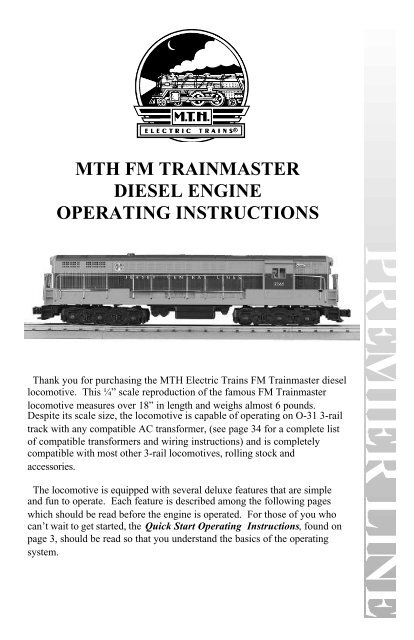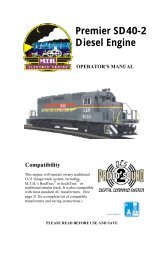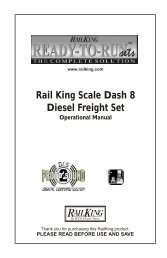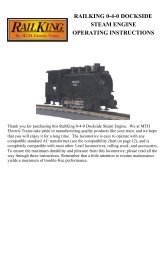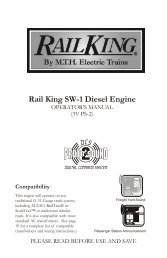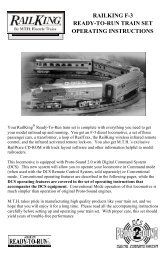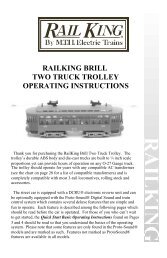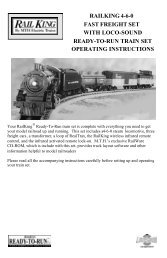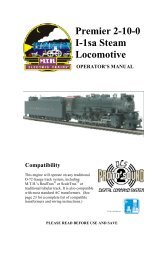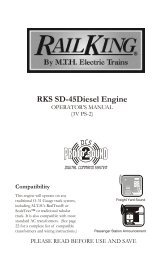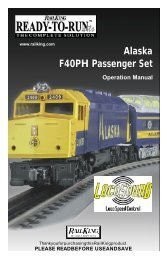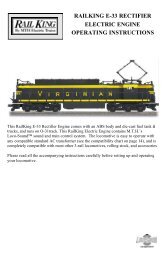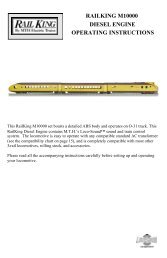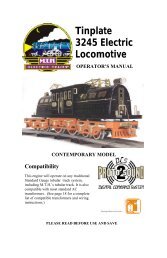mth fm trainmaster diesel engine operating instructions - MTH Trains
mth fm trainmaster diesel engine operating instructions - MTH Trains
mth fm trainmaster diesel engine operating instructions - MTH Trains
Create successful ePaper yourself
Turn your PDF publications into a flip-book with our unique Google optimized e-Paper software.
<strong>MTH</strong> FM TRAINMASTERDIESEL ENGINEOPERATING INSTRUCTIONSThank you for purchasing the <strong>MTH</strong> Electric <strong>Trains</strong> FM Trainmaster <strong>diesel</strong>locomotive. This ¼” scale reproduction of the famous FM Trainmasterlocomotive measures over 18” in length and weighs almost 6 pounds.Despite its scale size, the locomotive is capable of <strong>operating</strong> on O-31 3-railtrack with any compatible AC transformer, (see page 34 for a complete listof compatible transformers and wiring <strong>instructions</strong>) and is completelycompatible with most other 3-rail locomotives, rolling stock andaccessories.The locomotive is equipped with several deluxe features that are simpleand fun to operate. Each feature is described among the following pageswhich should be read before the <strong>engine</strong> is operated. For those of you whocan’t wait to get started, the Quick Start Operating Instructions, found onpage 3, should be read so that you understand the basics of the <strong>operating</strong>system.
Table Of ContentsQUICK START - BASIC OPERATION(All 3-Rail Models) 3PROTOSMOKE UNIT OPERATION 4PROTOSOUNDS® OPERATING INSTRUCTIONS 5ProtoSound® DCRU® Reverse Unit Operation (All 3-Rail Models) 5Horn Operation 6Bell Operation 6ProtoCoupler Operation 7Cab Chatter Sounds 8Squeaking Brake Sounds 8Tips On Using The Squeaking Brake Sounds 9Freight Yard Sounds (FYS) 10Activating and Triggering Freight Yard Sounds 10Tips On Using FYS Features 15Self-Recharging Battery Backup System 16Replacing The ProtoSound® Battery 16ProtoSound® Volume Adjustment 17USING “RESET" TO PROGRAM PROTOSOUNDS® 18Entering RESET Options 18Setting The Engine Volume 19Programming For A Separate Bell Button Controller 20Programming For Squeaking Brake Operation 20Programming For Horn In Neutral Operation 21Programming For ProtoCoupler Operation 22Programming For FYS Operation 23Activating Remote Lockout Control 23Programming For Cab Chatter Sounds 24ResettingAll ProtoSound® Options To Factory Default 24REVERSE UNIT LOCK-OUT OPERATION 25Locking The Engine Into Forward or Reverse 25Unlocking The Engine 25Locking The Engine Into Neutral 25OIL & LUBRICATION INSTRUCTIONS 27TRACTION TIRE REPLACEMENT INSTRUCTIONS 28LIGHT BULB REMOVAL & REPLACEMENT 29TROUBLE SHOOTING PROTOSOUND® PROBLEMS 30ProtoSound® RESET Feature Chart 33Transformer Wiring Chart 34SERVICE AND WARRANTY INFORMATION 35HOW TO GET SERVICE 35LIMITED ONE YEAR WARRANTY 352<strong>MTH</strong> FM Trainmaster Diesel Operating Manual
QUICK START - BASIC OPERATIONThe <strong>MTH</strong> FM Trainmaster contains state-of-the art electronics withseveral built-in automatic features for incredibly realistic operation. Despitethese advanced features, the FM Trainmaster is easy to operate with anycompatible standard AC transformer (see the compatibility chart on page34). All models are equipped with an <strong>operating</strong> smoke system that shouldbe primed with smoke fluid before <strong>operating</strong> . Adding 20 - 25 drops offluid through the smoke stack should be sufficient. If you choose to notprime the units with fluid, turn the smoke unit switch located under thetrailing truck to the OFF position. (See Figure 1) This will prevent anydamage from occurring to the smoke unit when running the <strong>engine</strong> withouta primed smoke unit. For moreinformation see the section on page 4Smoke Unit Switchon Smoke Unit operation.The FM Trainmaster model iscontrolled by a ProtoSound® DCRU®electronic reverse unit. The reverseunit operates in the same manner thatall reverse units function by usingforward, neutral and reverse states thatare entered each time the throttle isturned on and off or by using thetransformer direction switch (if soequipped).ProtoCouplerSwitchFigure 1: Locating The Smoke Unit Switchand ProtoCoupler Switch.NeutralThe reverse unit is designed toRESETForwardReverseignore dirty track, dead spots onNeutralswitches or minor short circuitsFigure 2: ProtoSound® DCRU® Cycle Phaseswithout disrupting the <strong>engine</strong>operation, even at slow, prototypicalspeeds. Once the <strong>engine</strong> is placed on the track, the transformer throttle canbe advanced. You will see that only the <strong>engine</strong>’s lights come on and twodings from the sound system will chime followed by the air compressorpump sounds. The <strong>engine</strong> does not run. This is known as the RESET stateand is explained in more detail beginning on Page 5. The ProtoSound®DCRU® will not power the motor until the throttle is turned OFF and thenON again. At this point, the <strong>engine</strong> will now function just like any otherelectronic or mechanical E-unit.3<strong>MTH</strong> FM Trainmaster Diesel Operating Manual
PROTOSMOKE UNIT OPERATIONThe FM Trainmaster contains a self-powered smoke unit that outputs a steady stream ofsmoke through the smoke stack on the roof of the <strong>engine</strong>. The ON/OFF switch located next tothe power truck must be in the ON position in order for the smoke unit to function. See Fig. 1on page 3.The smoke unit is essentially a small heating element and wick which soaks up and then“cooks" a mineral oil-based fluid that omits a harmless smoke. The smoke is then forced outof the stack via a small electric fan which runs at a constant speed. However, the smokeintensity can be varied by increasing the transformer voltage setting. The higher the setting,the more intense the smoke output.For best results, we recommend that you add 20 - 25 drops of ProtoSmoke, Seuthe, LGB orLVTS fluid before you run the <strong>engine</strong>. If you don’t choose to add the fluid, then the smokeunit switch should be turned off. Failure to either add the fluid or turn the switch off couldlead to damage to the smoke unit heating element and or wicking. Add the fluid through thesmoke stack hole. After adding the fluid, gently blow into the stack to eliminate any airbubbles. Do not overfill the unit as overfilling can cause the fluid to leak out and coat theinterior <strong>engine</strong> components. When the smoke output begins to diminish while running the<strong>engine</strong>, an additional 20-25 drops of smoke fluid should be added or the smoke unit switchshould be turned off. When storing the <strong>engine</strong> for long periods of time, you may want to add atleast 20 drops of fluid to keep the wick soaked with fluid and prevent it from drying out. Afterremoving the <strong>engine</strong> from storage, it is advisable to add another 25 drops of fluid, letting thewick soak up the fluid for 15 minutes prior to operation.SMOKE UNIT MAINTENANCECAUTION: Operating the <strong>engine</strong> without smoke fluid and with the smoke unit switch in theON position can damage your smoke unit wick, causing the wick to become hard, blackenedand unabsorbant around the heating element.When this occurs, it may be difficult for thewick to soak up the smoke fluid resulting inpoor or no smoke output. If that occurs, werecommend that you inspect and/or replace thewick taking care to not run the <strong>engine</strong> withoutfluid in the future. You can inspect the wick tosee if it needs replacement by removing thesmoke unit circuit board from the smoke unitbody as seen in Fig.2. After removing thecircuit board screws lift the circuit board awayand inspect the wick. If the wick is darklydiscolored and hard, it should be replaced.Smoke UnitCircuit BoardMounting ScrewsAfter RemovingMounting Screws,Lift Circuit BoardTo Reveal WickingFigure 2: Inspecting The Smoke Unit4<strong>MTH</strong> FM Trainmaster Diesel Operating Manual
PROTOSOUNDS® INSTRUCTIONSThe <strong>MTH</strong> ProtoSound® digital sound and train control system providesthe operator with unprecedented realistic operation on your model railroad.In addition to actual <strong>diesel</strong> <strong>engine</strong>, CD-equivalent 16-bit digital sounds,you get the following features:1. ∗ Built-In ProtoSound® DCRU® Reverse Unit * Authentic Diesel Horn Sound*Authentic Diesel Bell Sound* Squeaking Brake Sound* Freight Yard Sounds*Operating Remote Controlled ProtoCoupler* Self-Recharging BatteryBack-Up System With Automatic Battery Shut-Off* Remotely ControlledReverse Unit Lock-Out* Remotely Adjustable Diesel Engine Volume* AuthenticCab Chatter Neutral Sounds* Authentic Diesel Engine Startup & ShutdownSounds *Each feature is described among the following pages. Though the systemis easy to use, we encourage you to read the <strong>instructions</strong> thoroughly.PROTOSOUND® DCRU® REVERSE UNITAs mentioned in the Basic Operating section, the <strong>engine</strong> is controlled by aDCRU® reverse unit that contains the standard forward-neutral-reversestates found on most reverse units. However, as described earlier, whenpower is first applied to the track, the reverse unit begins in RESET or whatseems like a neutral state. Power must be interrupted again to get thelocomotive to enter the forward state. It is this first RESET state that givesProtoSound® its unique, remote controlled functions. The system will enterRESET whenever power to the track is off for three or more seconds.NEUTRAL will be referred to as the state between Forward and Reverse.ProtoSounds® is equipped with a microprocessor, that, depending on theamount of memory it is allotted, allows the user to utilize several remotelyactivated functions. In the simplest terms, ProtoSounds® has its own“Computer" controlling these functions. In fact, the power of thismicroprocessor is the same as that of a 286 desktop computer! In order toaccess many of these remotely controlled functions, the user must be in theRESET state to do so. RESET is entered anytime power to the locomotivehas been off for more than 3 to 5 seconds. When the <strong>engine</strong> first entersRESET, the microprocessor initiates a system check to determine if thesystem, transformer and <strong>engine</strong> are <strong>operating</strong> correctly. This takesapproximately 2.2 seconds during which you will hear the <strong>engine</strong>’s startupsounds begin. In order for ProtoSounds® to properly initiate the system5<strong>MTH</strong> FM Trainmaster Diesel Operating Manual
check, do not advance the transformer throttle past 10 volts when you firstenter RESET, wait for the <strong>diesel</strong> startup sounds to begin and then slowlyturn the transformer throttle to the off position and then back on again toenter the forward phase. Interrupting the power too quickly may cause thesystem to re-enter RESET (signaled by two dings of the bell). Should thishappen, wait longer before interrupting the power to enter the Forwardphase.ProtoSounds® comes with several programmable functions, includingremote Diesel Engine Volume Adjustment, Separate Bell Button Operation(pre-programmed at the factory), Horn In Neutral Operation,ProtoCoupler On/Off Control, Squeaking Brakes and Passenger Stationor Freight Yard Proto-Effects. Each of these features are described in moredetail later. You will notice that when in RESET, your <strong>engine</strong> will notrespond to the whistle button with a horn blast or continuous bell ringing.In fact, when in RESET and the whistle button is depressed, only one singlebell chime will be heard each time the whistle button is pressed. If youdon’t want to configure or change your locomotive using any of theseprogrammable features, simply leave RESET and wait 2.2 seconds beforeinterrupting the power to put the <strong>engine</strong> in forward. After you leaveRESET, your <strong>engine</strong> will operate normally in all the direction states offorward, neutral and reverse. Remember though, once power is turned offfor more than 3 seconds, the next time power is applied to the track, your<strong>engine</strong> will be back in RESET.HORN OPERATIONYour FM Trainmaster ProtoSound®-equipped <strong>engine</strong> is equipped with adigital recording of a <strong>diesel</strong> horn. The horn sound can be activated anytimethe <strong>engine</strong> is in forward or reverse by pressing the whistle button on yourtransformer. The horn will continue to blow as long as the whistle button isdepressed. The horn will not function in RESET and must be configuredthrough a RESET option to allow the whistle to work when the <strong>engine</strong> is inneutral. See page 21 for information on horn programming in the UsingRESET To Program ProtoSounds® section of this manual.BELL OPERATIONYour FM Trainmaster ProtoSound®-equipped <strong>engine</strong> is equipped with adigital recording of an actual <strong>diesel</strong> <strong>engine</strong> bell. The bell can be turned onor off with any separate bell button, like the Lionel® Railsounds® No. 59066<strong>MTH</strong> FM Trainmaster Diesel Operating Manual
Bell Button, by simply pushing the button. If you don’t have a separatebell button, the bell can be controlled through your transformer’s whistlebutton whenever the <strong>engine</strong> is in NEUTRAL. The bell will never ringcontinuously in RESET (Remember NEUTRAL is the state betweenForward and Reverse). Once the bell is turned on, it will continue to ringwhen the <strong>engine</strong> is cycled into forward or reverse until you press the bellbutton or re-enter NEUTRAL and turn the bell off with the whistle button.In fact, because of ProtoSounds® state-of-the-art design, themicroprocessor remembers its last command. Therefore, unless you turnthe bell off before you quit running your train, the next time you run the<strong>engine</strong>, the bell will come on. No matter whether you come back an hourlater or a year later, the bell will begin chiming once the <strong>engine</strong> enters oneof the three directional states.To turn the bell on using the transformer’s whistle button, turn on power tothe track and cycle the <strong>engine</strong> into NEUTRAL. Turn the throttle to 8 voltsor less (any higher voltage will arm the ProtoCoupler) and press thewhistle button. The bell should begin chiming. To turn the bell off, pressthe whistle button again. If you want to keep the bell on while running the<strong>engine</strong>, simply interrupt the power with the transformer throttle or thetransformer directional switch and enter forward or reverse.PROTO-COUPLER OPERATIONYour FM Trainmaster ProtoSound®-equipped locomotive is equippedwith two coil-wound ProtoCouplers for remote uncoupling action.Because the ProtoCoupler is controlled through ProtoSounds®microprocessor, it doesn’t require an uncoupling track section ormodification to your layout to function. The three simple steps below arerequired to operate the coupler.1. Put your <strong>engine</strong> in NEUTRAL and turn the throttle all the way up.2. Press the transformer whistle button to “Arm" the coupler. (Youwill hear a “Clank").3. After arming thePut Engine In Neutralcoupler, press the whistleAt Full PowerListen For TheCa-Clunk Soundbutton again to open thecoupler. H HSee The Coupler OpenAnd Listen For TheCha-Chusshh SoundPress & ReleaseThe Whistle ButtonPress & ReleaseThe Whistle Button7<strong>MTH</strong> FM Trainmaster Diesel Operating Manual
When the knuckle fires open you will hear the buzzing of the coilenergizing and the sound of the air lines coming apart. It can best bedescribed as a CHA-CHUSHHH sound. The coupler doesn’t have to befired in NEUTRAL. Once thecoupler is armed it can be firedin Forward, Neutral or Reverse.However, you may find that thecoupler doesn’t open whenfiring the coupler at highspeeds. Reduce the voltagesetting on your transformer ifthis occurs and run your <strong>engine</strong>at a slower speed before firingthe coupler. If the couplercontinues to open erratically, try lubricating the knuckle with light oil asindicated in Fig. 3.For multiple heading purposes, only one of the two ProtoCouplers willfunction at any one time. Use the coupler direction switch as shown inFigure 1 on page 3 to select either the front or rear coupler. Simply slidethe switch toward the direction of the coupler you want to make active.NEUTRAL-ACTIVATED CAB CHATTER SOUNDSYour <strong>engine</strong> is equipped with four dispatacher-to-<strong>engine</strong>er “Cab Chatter”radio transmissions that occur every 2 to 30 seconds. Each sequence willplay at random intervals to eliminate repetition. While the sounds areselected to play randomly by the microprocessor, there is no guarantee thatyou won’t hear the same message repeated twice or more times.SQUEAKING BRAKE SOUNDSProtoSound® equipped <strong>engine</strong>s feature the ability to play the sound ofsqueaking brakes whenever your <strong>engine</strong> slows in speed. There are twosettings for activating the squeaking brake sounds. The default settingallows the brake sounds to playwhile the <strong>engine</strong> is in forward orreverse and the transformerthrottle is lowered from a highsetting (greater than 14v) to alow setting (less than 8v). Thesecond setting requires that a bellLubricateProtoCouplerKnuckleFigure 3: Lubricating The ProtoCouplersThrottle Down FromHigh Voltage To LowListen For TheSqueaking Brake Sounds8<strong>MTH</strong> FM Trainmaster Diesel Operating Manual
utton be used to “arm” the brake feature and is explained in more detail inthe “Activating Freight Yard Sounds” section found later in this manual.The sound itself is a stored recording on the ProtoSounds® software chipand will always play the same brake sound for the same three second lengtheach time the voltage is reduced from high to low. Some practice may berequired to synchronize the playing of the brake sounds with the movementof the <strong>engine</strong>. It is not uncommon for the <strong>engine</strong> to stop before the brakesound is completed. Operators will find that by coordinating the movementof the throttle setting from 8 volts to off will allow the <strong>engine</strong> to maintain itsmovement while the brake sounds play. Note: The brake sounds will notbe heard if the transformer throttle is not set above 14 volts, thenreduced below 8 volts.TIPS ON USING THE SQUEAKING BRAKE FEATUREBecause the squeaking brake feature always plays for approximately 3seconds, it is possible that the brake sounds will play longer or shorter thanwhat visually seems prototypical. You will find that by practicing with thebrake feature, you can quickly determine how quickly to throttle down andwhich speeds and voltage settings will give you the most prototypical brakingeffect.Typical users will find the feature to be a very realistic way to simulate thesound of an <strong>engine</strong> slowing down for curves, crossings or coming to a stop at astation, side track or switch yard. As mentioned above, you will find thatinitially your <strong>engine</strong> may continue to play the brake sounds once your <strong>engine</strong>comes to a stop or that the sounds stop prematurely before the <strong>engine</strong> comes toa complete halt. For example, if you simply run the <strong>engine</strong> and turn the throttleoff quickly, the brake sounds will likely continue playing even though the<strong>engine</strong> has come to a complete stop. This annoying effect can be eliminated bysimply practicing with the brake feature. In no time, you will quickly learnhow to “feather" the throttle to keep the <strong>engine</strong> moving while the brake soundsplay and then turning the throttle off just as the sounds stop. Remember thatonce you stop the <strong>engine</strong>, you should turn the throttle to the off position if youdon’t want to activate the Freight Yard Sounds feature described later in thismanual.The ProtoSound® squeaking brake feature also has the ability to simulate thesqueal of wheel flanges when your train enters a curve at high speeds. Thesame brake squeaking sound plays, but you don’t need to reduce thetransformer throttle to activate the squeaking sounds. To play the squeakingsounds as wheel flange sounds, trigger the brake feature using either method 1or 2 above. Once triggered set the transformer throttle setting at 14 volts orhigher. As your <strong>engine</strong> enters a curve (or anywhere on the layout) quickly“flick" your transformer whistle button about half way. This “flicking" actioncauses the transformer to release a short DC signal that ProtoSounds® reads asan indicator to activate the brake sounds. The <strong>engine</strong> won’t slow down eventhough the sounds play. This simulates the wheel flange squeal of a traintraveling through a turn too quickly.9<strong>MTH</strong> FM Trainmaster Diesel Operating Manual
FREIGHT YARD SOUNDS (FYS)ProtoSounds® comes equipped with operator controlled Freight YardSounds, hereby referred to as FYS. This easy to use feature plays digitallyreproduced freight yard sounds whenever your <strong>engine</strong> stops on your layoutand is parked in the Neutral position. No additional wires or modificationsare needed on your layout to enjoy these amazing sound effects. Thesounds themselves are randomly generated and randomly “shuffled” on theProtoSounds® software chip. This gives the system the ability to producedifferent sounds in a different order each time FYS is enabled. Thesedifferent sounds are heard each time you cycle the transformer throttle fromON to OFF in the same manner that you would cycle the throttle to enter thevarious states of Forward, Neutral and Reverse. The entire FYS sequence isdesigned to simulate the arrival, loading or unloading and departure of afreight train in a freight yard. Each sequence is described in more detail inthe following sections.USING FREIGHT YARD SOUNDSYour ProtoSound® equipped <strong>engine</strong> features an operator controlled freightyard sound set. Once activated, this easy-to-use feature plays the sound offreight yard activitities whenever the operator parks the <strong>engine</strong> in theneutral position.ARMING THE FREIGHT YARD FEATUREBefore FYS can be heard, ProtoSound® must be told to activate thefeature the next time the <strong>engine</strong> enters the neutral position. This can beaccomplished in one of two ways.Option 1: If you are using a separate bell button controller to ring yourbell (like the Lionel® Railsounds® number 5906 bell activation button),you can activate the feature by pressing and holding down the bell buttonfor three or moreseconds (it doesn’tmatter if you are inForward, Neutral orReverse). You will hearthe bell chiming turn onand if you listenPut Engine In Neutral,Forward or ReversePress & HoldThe Railsounds® Bell ButtonFor 3 SecondsListen For TheStart Of The Bell SoundListen For TheAir Release SoundAfter 3 Seconds10<strong>MTH</strong> FM Trainmaster Diesel Operating Manual
carefully, you should hear an air release sound after three seconds havepassed. At this time you can release the bell button. (Note: because the airrelease sound may be difficult to hear, we recommend that you count out afull three seconds before releasing the bell button.) The bell will continueto chime, so if you want to turn off the bell ringing, simply press and releasethe bell button a second time. If you were in Neutral when you triggeredthe brake feature, interrupt the transformer throttle to enter either forward orreverse and allow the <strong>engine</strong> to begin moving. (Note: the feature will onlybe activated in the first direction state you enter after arming the featurefrom the Neutral position. You cannot interrupt the power twice to enteranother direction state and still have the brake feature active.) Once your<strong>engine</strong> begins moving, you can trigger the sounds to begin playingwhenever you enter Neutral.Option 2: If you do not have a separate bell button on your layout, youcan still activate the feature with your transformer whistle button. Toactivate the feature, turn on the transformer throttle and get your <strong>engine</strong> intothe Neutral position (not RESET). Once in Neutral, set the transformerthrottle at 8 volts or less and press and hold the whistle button for at leastthree seconds. You will hear the bell chiming begin and if you listencarefully, you should hear an air release sound after three seconds havepassed. At this time you can release the whistle button. (Note: because theair release sound may be difficult to hear, we recommend that you count outa full three seconds before releasing the whistle button.) The bell willcontinue to chime, so if you want to turn off the bell ringing, simply pressand release the whistlebutton a second time.Interrupt the transformerthrottle to enter eitherforward or reverse andallow the <strong>engine</strong> to beginmoving. (Note: the featurewill only be activated in thePut Engine In NeutralAt Low Powerfirst direction state you enter after arming the feature from the Neutralposition. You cannot interrupt the power twice to enter another directionstate and still have the brake feature active.) Once your <strong>engine</strong> beginsmoving, you can trigger the sounds to begin playing whenever you re-enterNeutral.HPress & HoldThe Whistle ButtonFor 3 SecondsListen For TheStart Of The Bell SoundListen For TheAir Release SoundAfter 3 Seconds11<strong>MTH</strong> FM Trainmaster Diesel Operating Manual
ACTIVATING THE FREIGHT YARD SOUNDSBefore FYS can be heard, the feature must be armed as described on theproceeding pages. Once armed, activating the FYS effects is accomplishedby simply interrupting the transformer throttle and parking the <strong>engine</strong> in theNeutral position with track power remaining on. Remember, power to thetrack must remain on while the <strong>engine</strong> sits in Neutral in order for the FYSeffects to operate.At this point ProtoSounds® has taken over control of your <strong>engine</strong> anddisabled the bell and whistle buttons from responding to any futher operatorinput. In addition, ProtoSounds® has reconfigured the way the reverse unitfunctions by disabling the Reverse state during operation of the FYSeffects. This forces the <strong>engine</strong> to leave your freight yard in the samedirection that it arrived in. The following operator controlled “events”control FYS’s actions and sound effects.Event 1 (Forward) While the locomotive is running in forward (orreverse) FYS is activated by the operator pushing and holding the bellbutton down for three or more seconds. The locomotive bell beginschiming and can be left on or turned off without disabling FYS.Event 2 (Neural Before Reverse) The operator now interrupts thetransformer throttle to stop the <strong>engine</strong> and put it into Neutral. If the throttlesetting was at 14 volts or higher , ProtoSounds® will play the sound ofsqueaking brake sounds as the <strong>engine</strong> comes to a halt.A. Upon stopping of the <strong>engine</strong>, the operator must immediately turnthe throttle back on to keep the <strong>engine</strong> in the Neutral position. If thebell was not turned off after activatingFYS, it now turns off automatically.Put Engine In NeutralAt Low PowerNote: Failure to turn the throttle backon within 3 seconds of leaving theForward phase will disable FYS andshutdown ProtoSounds®. The next timeyou turn power back on your <strong>engine</strong> willbe in the RESET position. See page 5 for more information onRESET.12<strong>MTH</strong> FM Trainmaster Diesel Operating Manual
B. After entering Neutral, ProtoSounds® will immediately play anair release sound followed approximately 2 seconds later by a radioarrival message (cab chatter).Immediately following the radio arrivalmessage, the sound of freight car doorscan be heard opening, followed by thesounds of freight loading and unloading.At this point various freight yard soundscan be heard including theloading/unloading operation, <strong>engine</strong>sounds, yardman “slang”, and additionalfreight car door sounds.Event 3: (Reverse) The operator now interrupts the transformer throttleagain to enter the next reverse unit phase; reverse. In an effort to enhancerealism, FYS has disabled the reversephase so that it doesn’t power the motorscausing the <strong>engine</strong> to move backward.Upon entering reverse, FYS confirms tothe operator that it has entered the reversephase by immediately playing a highlightsound best described as a rumbling sound.You may have to go through the entireFYS sequence several times before you canclearly identify this sound. After the rumbling highlight is played, thefreight yard sounds heard in Event 2 continue to play randomly.Event 4: (Neutral Before Forward) The operator now interrupts thetransformer throttle again to enter the next reverse unit phase, neutral beforeforward. FYS confirms to the operator that it has entered the neutral beforeforward phase by emitting two quick air release sounds. This is followedapproximately two seconds later by a radiodeparting message and continued freightyard loading and unloading sounds.Listen For Air Release SoundAnd Cab Chatter MessageInterrupt Throttle ToEnter The Next PhaseInterrupt Throttle ToEnter The Next PhaseListen For EngineRumbling SoundEvent 5: (Forward) The operator nowinterrupts the transformer throttle again toenter the next reverse unit phase; Forward.Listen For 2Air Release Sounds13<strong>MTH</strong> FM Trainmaster Diesel Operating Manual
FYS confirms to the operator that it has entered the Forward phase byplaying a radio message followed by the freight car door closing. Within 2seconds of the door closing, the locomotive will give two or three whistleblasts depending on leaving direction. Followed by the bell chiming. Afterapproximately 8 chimes of the bell, the<strong>engine</strong> begins moving in the forward phasewith the bell continuing to ring another 8chimes before automatically turning off.Once the bell turns off, the operator regainscontrol of the transformer whistle and bellbuttons and can ring the bell or blow thewhistle as usual.Interrupt Throttle ToEnter The Next PhaseListen For The SoundOf Box Door ClosingNote: When entering the Forward phase of FYS, itis important to set the transformer throttle at a high enough setting that will allow the <strong>engine</strong>to begin moving once FYS automatically activates the motors. Otherwise the <strong>engine</strong> will justsit still until you increase the transformer throttle setting on the transformer. However, don’tset the throttle setting too high or the <strong>engine</strong> will go racing away faster than you might expect.TIPS ON USING FYS FEATURESFYS is a unique feature of ProtoSounds® that is completely controlled by theoperator. You decide how, when or if you want to utilize the feature. Byreviewing the following tips, you should find solutions or suggestions to thevarious <strong>operating</strong> scenarios you might encounter when using FYS.Tip #1: You can escape the FYS sequence by interrupting the transformerthrottle before the radio message in Event 2 (neutral before reverse).Tip #2: You can terminate FYS at anytime by turning the transformerthrottle Off for 15 seconds.Tip #3: You do not have to be in the Forward phase to utilize FYS. Forexample, if you activate the FYS feature while in Reverse and interrupt thethrottle to enter Neutral, you will be entering Neutral Before Forward ratherthan Neutral Before Reverse as defined in Event 2 above. Consequently, theForward phase will be rendered inactive by ProtoSounds® instead of theReverse phase as explained in Event 3. This will allow your train to leave theyard in the reverse direction that it arrived.14<strong>MTH</strong> FM Trainmaster Diesel Operating Manual
Tip #4: You can utilize FYS even if you are double-heading with another<strong>engine</strong> regardless of whether the second <strong>engine</strong> is equipped with an FYSprogrammed ProtoSound® module. If the second <strong>engine</strong> isn’t equipped withFYS, the only thing to remember is that you not turn up the transformer throttlevery high when entering the Reverse phase found in Event 3. If the throttle isset too high, then the second locomotive will begin vibrating on the track as itsmotors will be turning in the reverse state since they cannot be disabledautomatically like FYS equipped <strong>engine</strong>s. If your second <strong>engine</strong> is equippedwith FYS, you may want to disable it when used in double-headed operations.To disable FYS, see the section on programming for squeaking brakes and FYSoperation on page 22 and page 23 of this manual.Tip #5: It is not necessary for the squeaking brake sounds to be heard to playthe FYS sounds. For example, the brake sounds won’t be heard if the highvoltage setting is below 13 volts when the power is interrupted to enter theNeutral state.Tip #6: You can leave any of the event states at any time after entering thestate by simply interrupting the transformer throttle. Any sound effectsprogrammed to play in that event will simply not occur. The only exception isEvent 2 and Event 5. In Event 2, interrupting the throttle has no effect on FYSuntil after the radio message and the freight car doors have opened. In Event 5,you cannot interrupt FYS until after the <strong>engine</strong> begins to move. Interruptingthe throttle before the <strong>engine</strong> begins to move has no affect on the locomotive’soperation.15<strong>MTH</strong> FM Trainmaster Diesel Operating Manual
Note: Consistent activation of the wheel flange squealing is determined by the condition ofyour transformer’s whistle button rectifier disc. Older rectifier discs may need to be replacedin order to play squealing sounds.SELF-RECHARGING BATTERY BACKUPProtoSounds® state-of-the-art design includes a self-recharging batterybackup system for improved performance at any speed. The battery ensuresthat power to the sound system will remain on during directional changes,setting RESET options or when travelling over dirty track and switches.The self-recharging battery backup system is automatically turned on or offwhenever track power is turned on or off. There are no switches needed toenjoy the benefits of the automatic battery backup system.ProtoSounds® contains a warning alarm if the battery backup system failsto automatically disengage when track power is turned off. Should thebackup system fail, you will hear a repeating whistle blast indicating thishas occurred. Should this happen, unplug the battery from theProtoSound® module (to prevent the battery from being run down) andcontact <strong>MTH</strong> for <strong>instructions</strong> on returning the locomotive for repair.REPLACING THE PROTOSOUND® BATTERYThe ProtoSound® battery (located inside the cab body), is a special NiCad7-cell, 8.4v battery - NOT the 6-cell, 7.2v battery found in mostconvenience stores. The 6-cell NiCad is NOT recommended for use withProtoSound® applications. The battery is continually charged from thetrack when power is applied and should last for up to five years. Inaddition, the NiCad battery is a dry battery and should not leak or cause anydamage to your locomotive during its lifetime.If you notice that the sounds seem distorted or garbled at low voltages orbecome silent when power from the transformer is shut off, the battery maybe going bad. Before replacing the battery, you should put the <strong>engine</strong> inNEUTRAL and leave the transformer throttle set at about 12 volts for 15minutes. This should temporarily recharge the battery. If the garbled ordistorted sounds are reduced, then your battery charge has worn down. Youcan give your battery a full charge by leaving the <strong>engine</strong> ON in theNEUTRAL position for 18 hours. (Make sure the smoke unit switch is inthe OFF position to prevent harm to the smoke unit wicking).16<strong>MTH</strong> FM Trainmaster Diesel Operating Manual
If you need to replace the battery, replacement ProtoSound® batteries areavailable from <strong>MTH</strong> ProtoSound® Electronics at 7020 Columbia GatewayDrive, Columbia, MD 21046. A standard 9v alkaline battery can besubstituted as a temporary fix, but since alkaline batteries can’t take acharge, it will eventually wear down. Regardless, it should give you a weekto a couple of months use while you wait for your replacementProtoSound® battery to arrive.PROTOSOUND® VOLUME ADJUSTMENTYour ProtoSound® system has two types of volume adjustment. Amanual turn knob on the bottom of the chassis (See Fig. 4 below) allowsyou to control all the sounds in the system and a remote control “RESET"option (Option # 6), allows you to control the volume level of the <strong>engine</strong>sounds remotely from the transformer. Turning the volume adjustmentknob clockwise will increase the volume and counterclockwise will lowerthe volume of all sounds; bell, horn, <strong>engine</strong> sounds, Cab Chatter, etc. Forinformation on <strong>operating</strong> the RESET volume adjustment option, see thesection entitled “Programming ProtoSound RESET Options” on thefollowing pages.Proto-Sound® Volume Adjustment KnobFigure 4: Adjusting The ProtoSound® Volume and selecting the ProtoCoupler17<strong>MTH</strong> FM Trainmaster Diesel Operating Manual
USING “RESET" TO PROGRAMPROTOSOUNDS®As mentioned earlier, there are several programmable options in eachProtoSound®-equipped <strong>engine</strong> that can be remotely set from anycompatible standard AC transformer equipped with a whistle button. For alist of compatible transformers, see the chart on page 34. This hands-offapproach gives you unprecedented control of your railroad empire’s motivepower never before seen in model railroading. Each programmable featurecan be accessed whenever your <strong>engine</strong> is in the RESET state as describedearlier on page 5. By following the <strong>instructions</strong> below you will find theprogramming easy and straight forward.ENTERING RESET OPTIONSProtoSound® is equipped with a few programmable features that areaccessed in the RESET state by moving the transformer throttle up anddown between full voltage and low voltage (8 volts or less) without shuttingthe transformer off completely. Each time this is done you advance, onefeature at a time, through the available options. An air-release sound isheard each time the throttle is advanced. In addition, there are specialsounds to tell you what RESET position you are in.For example, if you want to select Feature 2, you put the <strong>engine</strong> inRESET, and move the throttle up and down from full throttle to low twotimes. After the second advance, you will hear two “clinks" indicating thatthe computer is now in Feature 2. Advance the throttle again and you willhear three “clinks" for Feature 3. Advance it two more times and you willhear a “clank" indicatingthat you are now inFeature 5. Advance thethrottle two more timesand you will hear a“clank" and two “clinks"indicating Feature 7. ((5throttle advancements = 1clank) + (2 throttleIn RESET ModeMove The ThrottleUp & Down FromHigh Voltage To Low2 TimesListen For The2 Clink SoundsAdvance The ThrottleUp & Down FromHigh Voltage To Low4 More TimesListen For 1 ClankAnd 1 Clink Soundsadvancements = 2 clinks)). “Clank + “Clink" + “Clink" = Feature 7. Youcan advance the throttle as quickly as you like (though you may not hear theair-release sounds) and the computer will still remember the number of18<strong>MTH</strong> FM Trainmaster Diesel Operating Manual
times the throttle is advanced by playing back the number of “Clinks" and“Clanks" to confirm the feature you’ve selected.SETTING THE ENGINE VOLUMEOf all the sounds that come with each ProtoSound®-equipped locomotive,the one most often turned down is that of the <strong>engine</strong> volume because it isthe one sound normally heard whenever the <strong>engine</strong> is running and is whatusually can become tiresome to the ear over prolonged running sessions.The volume adjustment is controlled through RESET Feature 6.To access the feature, advance the transformer throttle to put the <strong>engine</strong> inRESET. Move the throttle up and down, as described on page 18, 6 times.After you hear the “clank" and “clink" indicating that you are in Feature 6,press the whistle button to select the <strong>engine</strong> volume level you desire.Pushing the whistle button once will give you full volume, which is thefactory setting. Pushing the whistle button a second time will give you 50%volume, pushing it a third time will give you 25% volume and pushing it afourth time will give you no sound. The microprocessor will immediatelyplay the sound level each time the whistle button is pushed so that you candecide if it is acceptable. You can recycle through the four choices bysimply continuing topress the whistle button.Once you have decidedon the appropriatevolume level, turn thetransformer throttle offand on again or pressIn RESET ModeMove The ThrottleUp & Down FromHigh Voltage To Low6 TimesListen For 1 ClankAnd 1 Clink SoundsPush The Whistle ButtonUntil You Reach TheSetting You Desirethe transformer direction switch to lock in your selection. The volumeadjustment will remain set at the level you have chosen until you change itagain. Regardless of the <strong>engine</strong> volume setting, the horn, bell, compressorand Cab Chatter sounds will function normally. In fact because only the<strong>engine</strong> volume is affected by selections in Feature 6, when you select 0volume, you can still hear the horn, bell and Cab Chatter sounds when the<strong>engine</strong> is running or in neutral.HInterrupt The ThrottleTo “Lock-In”The Volume Setting19<strong>MTH</strong> FM Trainmaster Diesel Operating Manual
PROGRAMMING FOR A SEPARATE BELL BUTTONCONTROLLERTo operate ProtoSounds® witha separate bell button controller,like the Lionel® No. 5906 bellbutton, you will need to wire upthe controller to yourtransformer and track as shownin Fig. 5. Once the button iswired, ProtoSounds® comespreprogrammed to allow you tooperate the bell by simplypushing the bell button once.To turn the bell off, push thebutton again. If the bell doesn’t’t function when you press the button, youmay need to re-program ProtoSounds® to operate with a separate bellbutton controller. To do this enter RESET and go to Feature 20. (See thesection Using RESET To Program ProtoSounds® on page 18.) Once inFeature 20, press the whistle button and wait for the module to sound a bellding(s). Continuepushing the whistlebutton until the moduleplays back two dings(signifying that themodule has beenprogrammed for a bellbutton). Simply turn theIn RESET ModeMove The ThrottleUp & Down FromHigh Voltage To Low20 TimesCommonthrottle off and then on again to “Lock-In" the new setting. To reset thecomputer to its original factory (default) setting (separate bell buttonoperation), repeat the above procedure but keep pushing the whistle buttonuntil the computer only responds with one bell ding.PROGRAMMING FOR SQUEAKING BRAKEOPERATIONRED WireBLACK WireProtoSounds® can be programmed for squeaking brake operation in threedifferent manners; (1)Squeaking brakes can be activated by bell buttoncontrol, (2)they can be programmed for continuous operation subject tothrottle changes or (3)they can be programmed to be turned off. The defaultsetting is (2) Squeaking brakes are activated for full-time operation asdescribed on page 8. To change the default setting, enter RESET and go toUAUBUCUDFigure 5: Wiring Up A Bell ButtonListen For 5 ClankAnd 0 Clink SoundsPush The Whistle ButtonUntil You Hear 2 DingsHInterrupt The ThrottleTo “Lock-In”The Bell Button Setting20<strong>MTH</strong> FM Trainmaster Diesel Operating Manual
Feature 45. (See the section Using RESET To Program ProtoSounds® onpage 18). Once in Feature 45, press the whistle button and wait for themodule to sound a bell ding(s). Continue pressing the whistle button untilthe module plays back one ding for option 1 - Squeaking brakes areactivated by the bell button. Press the whistle button again until the moduleplays back two dings for option 2 - squeaking brakes are activated forfull-time operation, orpress the whistle buttonagain until the moduleplays back three dings foroption 3 -Squeakingbrakes off. Once youhave decided on thedesired setting, simplyturn the throttle off andIn RESET ModeMove The ThrottleUp & Down FromHigh Voltage To Low45 TimesListen For 9 ClankAnd 0 Clink SoundsPush The Whistle ButtonUntil You Hear TheAppropriate # Of Dingsthen on again to “Lock-In” the new setting. To reset the computer to itsoriginal factory default setting (option 2 - squeaking brakes are activated forfull-time operation), repeat the above procedure but keep pushing thewhistle button until the module only responds with two bell dings.HInterrupt The ThrottleTo “Lock-In”The Brake SettingPROGRAMMING FOR HORN IN NEUTRALOPERATIONIf you are <strong>operating</strong> your <strong>engine</strong> with a separate bell button and want toblow your horn when your <strong>engine</strong> is in neutral, you will need to programProtoSounds® to do so as the factory setting only allows the horn to blow inforward or reverse. To do this, enter RESET and go to Feature 25. (See thesection Using RESET ToProgram ProtoSounds® onpage 18.) Once in Feature 25,press the transformer whistlebutton and wait forProtoSounds® to sound a bellding(s). Continue pressingthe whistle button untilProtoSounds® sounds twobell dings (signifying thatIn RESET ModeMove The ThrottleUp & Down FromHigh Voltage To Low25 TimesListen For 5 ClankAnd 0 Clink SoundsPush The Whistle ButtonUntil You Hear2 Bell DingsHInterrupt The ThrottleTo “Lock-In”The Horn Setting21<strong>MTH</strong> FM Trainmaster Diesel Operating Manual
ProtoSounds® has been programmed to sound the horn in neutral). Turnthe throttle off and then on again to “Lock-In" your selection. Now,whenever you are in neutral, you can blow the horn with the transformerwhistle button. To reset ProtoSounds® to its original factory setting of nohorn in neutral, repeat the above procedure but keep pressing the whistlebutton in Feature 25 until ProtoSounds® only dings once instead of twice.Note: When “Whistle In Neutral" is set, the bell will only operate with a separate bell buttonand the horn will not sound in neutral if the transformer throttle setting is over 11 volts. At 11volts or higher, ProtoSounds® may arm the coil coupler for operation whenever the whistlebutton is pressed and the <strong>engine</strong> is in neutral.PROGRAMMING FOR PROTOCOUPLER OPERATIONProtoSounds® comes witha RESET feature that allowsthe operator to remotely turnoff the ProtoCouplerfunctions. This is especiallyuseful when double ortriple-heading ProtoSound®equipped <strong>engine</strong>s since every<strong>engine</strong> equipped with aProtoCoupler will firewhen prompted to by theIn RESET ModeMove The ThrottleUp & Down FromHigh Voltage To Low10 TimesListen For 2 ClankAnd 0 Clink SoundsPush The Whistle ButtonUntil You Hear2 Bell Dingsoperator. By turning off the ProtoCoupler operation on certain <strong>engine</strong>s,you can fire the couplers open on the other <strong>engine</strong>s without uncoupling the<strong>engine</strong>s from each other. To turn the ProtoCoupler function off, enterRESET and go to Feature 10. (See the section on Using RESET ToProgram ProtoSounds® on page 18.) Once in Feature 10, press thetransformer whistle button and wait for ProtoSound® to sound a bellding(s). Continue pressing the whistle button until ProtoSounds® soundstwo bell dings (signifying that the ProtoCoupler option has been turnedoff). Simply turn the transformer throttle off and then on again to lock inthe new setting.PROGRAMMING FOR SQUEAKING BRAKES ANDFYS OPERATIONProtoSounds® is equipped with a RESET setting to turn off the FreightYard Proto-Effects (FYS) features. This is especially useful if you aredouble-heading <strong>engine</strong>s that are both equipped with FYS. You may notHInterrupt The ThrottleTo “Lock-In”The Coupler Setting22<strong>MTH</strong> FM Trainmaster Diesel Operating Manual
want to stop at a yard andhave both <strong>engine</strong>s playingtheir FYS sound effects. Toturn off FYS, enter RESETand go to Feature 28. (Seethe section on UsingRESET To ProgramProtoSounds® on page 18).Once in Feature 28, pressthe transformer whistlebutton and wait forProtoSounds® to sound a bell ding(s). Continue pressing the whistle buttonuntil ProtoSounds® sounds two bell dings (signifying that the FYS featureshave been turned off). Simply turn the transformer throttle OFF and thenON again to lock in the new setting. To reset ProtoSounds® to its originalfactory setting of FYS on, repeat the above procedure but keep pressing thewhistle button in Feature 28 until ProtoSounds® only dings once instead oftwice.ACTIVATING REMOTE LOCK-OUT CONTROLProtoSound® equipped <strong>engine</strong>s feature a RESET setting that allows theoperator to remotely “lock” the <strong>engine</strong> into forward, neutral or reverse.This is especially useful on layouts that feature “blocked” track sections.The lockout feature comes from the factory in the OFF position, meaning itis not active when you first take the <strong>engine</strong> out of the box. This is done toprevent novice operators from accidentally locking their <strong>engine</strong> intoforward, neutral or reverse and then mistakenly thinking that the <strong>engine</strong>’selectronics have failed. To activate the Remote Lockout Control setting, goto RESET Feature 40 (See the section entitled Using RESET To ProgramProtoSounds® on page 18). Once in Feature 40, press the transformerwhistle button and wait forProtoSounds® to sound abell ding. Continuepressing the whistle buttonuntil ProtoSounds® soundstwo bell dings signifyingthat the Remote LockoutControl has been selected.To lock in the setting,simply turn the throttle allIn RESET ModeMove The ThrottleUp & Down FromHigh Voltage To Low28 TimesIn RESET ModeMove The ThrottleUp & Down FromHigh Voltage To Low40 TimesListen For 5 ClankAnd 3 Clink SoundsListen For 8 ClankAnd 0 Clink SoundsPush The Whistle ButtonUntil You Hear2 Bell DingsHPush The Whistle ButtonUntil You Hear2 Bell DingsHInterrupt The ThrottleTo “Lock-In”The FYS SettingInterrupt The ThrottleTo “Lock-In”The Lock-Out Setting23<strong>MTH</strong> FM Trainmaster Diesel Operating Manual
the way off and then back on again. To turn the Remote Lockout Controlsetting back off, go back to Feature 40 and press the whistle button untilonly one bell ding sounds. To lock in the setting, simply turn thetransformer throttle off and then back on again. Alternatively, you can goto RESET Feature 18 to reset all ProtoSound® features back to theiroriginal factory defaults including Remote Lockout Control.RESETTING ALL PROTOSOUND OPTIONS TOFACTORY DEFAULTSProtoSounds® is equipped witha RESET feature (Feature 18)that resets all programmableoptions back to their originalfactory settings. This is a usefulfeature if you find your <strong>engine</strong>not <strong>operating</strong> the way you think itshould and don’t want to take theIn RESET ModeMove The ThrottleUp & Down FromHigh Voltage To Low18 TimesListen For 3 ClankAnd 3 Clink Soundstime to check each RESET feature one at a time. To reset all the RESETfeatures back to their original factory settings, enter RESET and go toFeature 18. (See the section entitled Using RESET To ProgramProtoSounds® on page 18). Once in Feature 18, press the transformerwhistle button and wait for ProtoSounds® to sound a garbled bell sound.Then interrupt the throttle to enter forward.TURNING OFF CAB CHATTER SOUNDSPush The Whistle ButtonUntil You HearA Warbled Bell Ding“Cab Chatter" sounds occur in the neutral position every 2 to 30 seconds.There are four “Chatter" messages which play at random times. This helpsto eliminate repetitive and boring messages. While the sounds are selectedto play randomly by the unit’s computer, there is no guarantee that youwon’t hear the same message repeated twice or more times. If you don’twant to hear the Cab Chatter sounds, they can be turned off through Feature23. To turn off the Cab Chatter sounds, enter RESET and go to Feature 23.(See the section Using RESET To Program ProtoSounds® on Page 18.)Once in Feature 23, press the transformer whistle button and wait forProtoSounds® to sound a bell ding(s). Continue pressing the whistle buttonuntil ProtoSounds® sounds two bell dings (signifying that the module hasbeen programmed to turn the Cab Chatter off). Simply turn the transformerthrottle off and then on again to lock in your selection. To turn the CabChatter sounds back on again, repeat the above process, but keep pressingthe transformer whistle button in Feature 23 until ProtoSounds® onlysounds one bell ding.24<strong>MTH</strong> FM Trainmaster Diesel Operating ManualHInterrupt The ThrottleTo “Lock-In”The Default Setting
REVERSE UNIT LOCK-OUT OPERATIONProtoSounds® unique design eliminates the need for a lock-out switch onthe locomotive by allowing the customer to lock the <strong>engine</strong> into anydirectional state (forward, neutral or reverse) from the transformer. Thiswill allow users to run the <strong>engine</strong> on layouts equipped with block signals orstop stations which would normally cycle the <strong>engine</strong> back into neutral. Thefeature must be first turned on by accessing RESET Feature 40 (See page23).LOCKING THE ENGINE INTO FORWARD ORREVERSETo lock the <strong>engine</strong> into Forward or Reverse, use the transformer throttle toenter Forward or Reverse (whichever state you want to lock the <strong>engine</strong> into)and while the <strong>engine</strong> is moving press the whistle button. WHILE THEHORN IS BLOWING TURN THE THROTTLE OFF AND THEN LETGO OF THE WHISTLE BUTTON. After about one second, you will heara short horn blast. QUICKLY TURN THE THROTTLE BACK ONAGAIN. Your <strong>engine</strong> is now locked into Forward or Reverse and it willremain so until you unlock the <strong>engine</strong>, even if you wait a year to run your<strong>engine</strong> again.UNLOCKING THE ENGINEUnlocking the <strong>engine</strong> is a similar procedure. WHILE THE ENGINE ISMOVING, PRESS THE WHISTLE BUTTON. WHILE THE HORN ISBLOWING, TURN THE THROTTLE OFF AND THEN LET GO OFTHE WHISTLE BUTTON. After three seconds without power you willhear one chime of the RESET bell. TURN ON THE POWER AGAIN.Your <strong>engine</strong> is now in RESET and will operate normally once you interruptpower and enter the forward direction.LOCKING THE ENGINE INTO NEUTRALTo lock the <strong>engine</strong> into the NEUTRAL position, PUT THE ENGINE INNEUTRAL AND WITH THE THROTTLE STILL ON, PRESS THEWHISTLE BUTTON. WHILE THE WHISTLE BUTTON IS BEINGPRESSED, TURN OFF THE THROTTLE AND LET GO OF THEWHISTLE BUTTON. After about one second, you will hear a short blast25<strong>MTH</strong> FM Trainmaster Diesel Operating Manual
of the horn. QUICKLY TURN THE POWER BACK ON AGAIN. Your<strong>engine</strong> is now locked into NEUTRAL.NOTE: When locking the <strong>engine</strong> in the Forward or Reverse positions, the whistle button willblow the whistle. But when locking the <strong>engine</strong> into the NEUTRAL position, the whistle buttonmay turn on or off sounds of the bell, coupler arming or coupler firing depending on thetransformer throttle voltage settings prior to the user’s attempt to lock out the <strong>engine</strong>.Remember, the whistle doesn’t blow in NEUTRAL (unless you programmed it to do so usingFeature 25. See page 21 for details), only the bell rings or the coupler operates in NEUTRAL.While it doesn’t make any difference on how the lockout function operates, you may hear oneof the three different NEUTRAL-activated sounds.To unlock the <strong>engine</strong> from the NEUTRAL position, follow the process tounlock the <strong>engine</strong> in the Forward or Reverse directions above.26<strong>MTH</strong> FM Trainmaster Diesel Operating Manual
OIL & LUBRICATION INSTRUCTIONSIn order for the <strong>engine</strong> to perform correctly and quietly, it is important thatthe chassis be lubricated before operation. Lubrication should include allGrease Gears (G)Lubricate Pickups (L)Figure 6: Lubricating The Locomotive ChassisLubricate Blind Wheel Axle (L)gears, axles and pickup rollers to prevent them from squeaking. Use lighthousehold oil and wheel bearing grease and follow the lubrication pointsmarked “L and G" in Fig. 6 above.The locomotive’s internal gearing has been greased at the factory andshouldn’t need additional grease until after 50 hours of operation or oneyear whichever comes first. Grease can be added by inserting grease intothe gear box inside the locomotive chassis. In order to access the gear box,the cab must be removed from the chassis by unscrewing the six chassisscrews as seen in Figure 8 on page 28. Once the cab is removed, the truckscan be removed by unscrewing the truck block/motor mount screw locatedon the underside of the drive trucks (See Figure 7). Grease can then beapplied into the gear box using a grease tube dispenser.Truck Block/Motor Mount Attachment ScrewFigure 7: Lubricate The Tender Chassis Trucks27<strong>MTH</strong> FM Trainmaster Diesel Operating Manual
Periodically, check the locomotive wheels and pickups for dirt buildup asthis can significantly affect the <strong>engine</strong>’s ability to perform properly. Dirtytrack and dirty wheels can cause both poor electrical contact as well as poortraction, especially on elevated track sections. Finally, dirt and oil build upcan prematurely wear out the neoprene traction tires.TRACTION TIRE REPLACEMENTINSTRUCTIONSYour locomotive is equipped with two neoprene rubber traction tires onthe middle wheel set of each drive truck. While these tires are extremelydurable and long-lasting there may arise a time where they will need to bereplaced. Should this occur, you will need to remove the trucks from thechassis and the trucksides from the trucks in order to slip the new tire overthe grooved drive wheel. Figures 7 and 8 identify the screws necessary toremove the body and trucks from the chassis.Before the new tire can be installed, you must make sure the old tire hasbeen completely removed from the groove in the drive wheel. Use a razorblade or small flatblade screwdriver pry away any remains left from the oldMotor Mount ScrewBody Mount Screw(one each end)Body Mount ScrewsFigure 8: Removing The Body From The Chassistire that may still be in the drive wheel groove. Once the old tire has beencompletely removed, slip the new tire onto the wheel. You may find ituseful to use two small flatblade screwdrivers to assist you in stretching thetire over the wheel. Be careful to avoid twisting the tire when stretching itover the wheel. If a twist occurs, the tire will have to be removed andreinstalled or a noticeable wobble in your <strong>engine</strong> will occur when <strong>operating</strong>the locomotive. In addition, it is important to make sure that the tire is28<strong>MTH</strong> FM Trainmaster Diesel Operating Manual
fully seated inside the groove. Any portion of the tire extending out of thegroove can cause the <strong>engine</strong> to wobble. A razor blade can be used to trimaway any excess tire that doesn’t seat itself inside the groove properly.Replacement tires are available directly from <strong>MTH</strong> Electric <strong>Trains</strong>.HEADLIGHT REPLACEMENTThe locomotive’s headlights are controlled by constant voltage circuitsinside the locomotive body. The headlight(s) can be easily removed fromits lampholder should the bulb expire. To remove the bulb, follow the bodyremoval <strong>instructions</strong> found in the Lubrication section on the proceedingpages. Once the cab has been separated from the chassis, gently unplug thebulb’s wire harness from the socket on the constant voltage circuit.Replacement bulbs are available directly from <strong>MTH</strong> Electric <strong>Trains</strong>.29<strong>MTH</strong> FM Trainmaster Diesel Operating Manual
TROUBLE SHOOTING PROTOSOUND®PROBLEMSAlthough ProtoSound® has been designed and <strong>engine</strong>ered for ease of use,some questions may arise during initial operation. The following tableshould answer most questions. If you find that your problem can’t beresolved with this manual, contact <strong>MTH</strong> ProtoSound® Electronics (7020Columbia Gateway Drive, Columbia, MD 21046, 410-381-2580) foradditional assistance.HORN PROBLEMSThe horn seems distorted at low voltages.When I press the whistle button, the bell comes oninstead.I can’t get the horn to blow when I press the whistlebutton.BELL PROBLEMSWhen I press the whistle button to activate the bell, thehorn sounds.When I press the whistle button to activate the bell, Iarm the coupler.When I press the whistle button to activate the bell, thebell only rings once.I can’t get the bell to ring when I press the whistlebutton.The bell won’t work with a separate bell button.REMEDYYour battery may be undercharged or dead. Tryrecharging the battery as explained in the batterysections.You are trying to operate the horn in neutral. The hornwill only operate in Forward or Reverse unless youprogram ProtoSounds through Feature 25. See the<strong>instructions</strong> in the section entitled “Using RESET toProgram ProtoSounds”. Also check the transformerwiring.You may be pressing the whistle button too quickly.Most older AC transformers contain a two--step whistlebutton that releases a DC signal onto the track. It isthis DC signal that tells the horn to blow. However,because the signal is weaker when the whistle buttonis depressed fully, the ProtoSound circuit may notrecognize the signal. Try pressing the whistle buttonslower, taking approximately 1 second to fully depressthe button.REMEDYYou are trying to ring the bell in Forward or Reverse.The bell only operates in Neutral unless you haveprogrammed ProtoSounds to recognize a separate bellbutton.Reduce the voltage on the transformer before pressingthe whistle button to activate the bell. The bell will onlycome on at 8 volts or less.You are trying to ring the bell in RESET instead ofneutral. Interrupt the power twice to enter Neutral, setthe voltage at 8 volts or less and press the whistlebutton to activate the bell.You may be pressing the whistle button too quickly.See the 3rd remedy in the horn section above.ProtoSounds must be programmed in order for aseparate bell button to function. Enter RESET functionnumber 20 (see the section entitled “Using RESET toProgram ProtoSounds”) and press the whistle buttonuntil the bell sounds two dings. Simply turn the throttleoff and then on again to lock in the new setting. Alsocheck the bell button wiring.30<strong>MTH</strong> FM Trainmaster Diesel Operating Manual
COUPLER PROBLEMSThe ProtoCoupler won’t let the <strong>engine</strong> uncouple on the“Fly”.I can’t get the coupler to arm or fire open when I pressthe whistle button.Only one coupler will function when I press the whistlebutton.DIESEL START/CAB CHATTERSometimes the <strong>diesel</strong> start sounds don’t occur when Ifirst turn power on.Sometimes the Cab Chatter sounds don’t play.LOCKOUT PROBLEMSI can’t get the <strong>engine</strong> to run after I power up thetransformer. It sits still with the <strong>diesel</strong> compressorsounds running.The <strong>engine</strong> won’t lock out into Forward, Neutral orReverse even after the short horn blast sounds.VOLUME PROBLEMSWhen I try to run the <strong>engine</strong>, the <strong>diesel</strong> volume is OFFor very low.When I try to set the <strong>diesel</strong> volume, it resets itself tothe original volume after I selected the new volume.When I try to set the Diesel Volume to O Volume, I stillhear the cab chatter sounds.The sounds seem distorted, especially when thewhistle or bell is activated.REMEDYThe power required to fire the coupler open when the<strong>engine</strong> is on the “Fly” may be greater than theProtoSound system is capable of providing. As aresult, you may experience times when the couplerwon’t fire open. Unfortunately, the only solution is tostop the <strong>engine</strong> and fire the coupler in Neutral. If thatdoesn’t resolve the problem, try lubricating the couplerknuckle and rivet as explained in the ProtoCouplerOperation section.You may be pressing the whistle button too quickly.See the third remedy in the horn section above.Another possibility is that ProtoSounds has beenprogrammed to turn the coupler function off. See thesection entitled “Using RESET to ProgramProtoSounds”Only one coupler can operate at any one time. Usethe coupler selection switch on the bottom of thechassis to choose which coupler you want active.REMEDYOccassionally the <strong>diesel</strong> <strong>engine</strong> start up sounds maynot occur when power is turned back on within 5seconds of being shut off. Wait 10 -- 15 secondsbefore repowering.The Cab Chatter sounds only play in neutral andProtoSounds may be programmed to turn the soundsoff. See the section entitled “Using RESET toProgram ProtoSounds”REMEDYThe <strong>engine</strong> is locked out into the Neutral position.Follow the unlocking proceedures in the LockoutSection.You are waiting too long to turn the throttle back onafter the short horn blast sounds. The power must beturned back on immediately after the short horn blastsounds or the <strong>engine</strong> will go back into RESET. Seethe lockout proceedure in the Lockout Section.REMEDYThe <strong>diesel</strong> volume has been programmed at a reducedvolume or to be silent. Go to RESET Feature 6 andadjust the volume. See the section entitled “UsingRESET to Program ProtoSounds” for moreinformation.You are trying to set the volume with a poorly chargedor dead backup battery. See the section on BatteryBackup for more information.When the <strong>diesel</strong> volume is set to O, you will hear theCab Chatter sounds because setting the <strong>diesel</strong> volumeonly controls the sound of the <strong>diesel</strong> <strong>engine</strong> itself. Allother sounds, including Cab Chatter, the horn and bellwill continue to play at the volume level set by themanual volume control knob located on the bottom ofthe chassis. See the section entitled “ProtoSoundVolume Adjustment” for more information.The overall ProtoSound volume has been set to highcreating the distorted sounds. Try turning the volumecontrol knob located on the bottom of the chassiscounter clockwise to reduce the overall volume level.31<strong>MTH</strong> FM Trainmaster Diesel Operating Manual
BATTERY PROBLEMSI get no sounds when the <strong>engine</strong> shifts between thedirection states.After I turn off my transformer, my <strong>engine</strong> continues tomake sounds before quitting with a ding of its bell.The sounds distort at low voltages.A repeating horn blast occurs after the power hasbeen shut down.RESET PROBLEMSWhen I first turn the power on, the <strong>engine</strong> will notbegin to run. I have to turn the throttle off and then onagain to get the <strong>engine</strong> to operate.Whenever I interrupt the power from RESET to enterForward, the <strong>engine</strong> goes back into RESET instead ofForward. I know this occurs because the bell dingstwice.BRAKE SOUND PROBLEMSWhen the transformer is throttled down, the soundswon’t play.The brake sounds continue to play even after the<strong>engine</strong> stops.The brake feature was activated in neutral after the<strong>engine</strong> was running in forward, but the brake soundswould not play when triggered after the <strong>engine</strong> wentback into forward or reverse.After triggering the brake sound and stopping the<strong>engine</strong> in neutral, the <strong>engine</strong> begins making freightyard sound effects.REMEDYThe battery may be dead or needs charging. See theBattery Backup section for more information.ProtoSounds continues to sound for approximately 10seconds after power to the track has been shut off.The battery is insufficiently charged or dead. Followthe recharging <strong>instructions</strong> found in the section entitled“Self Recharging Battery Backup System”.The ProtoSound module has detected a problem withthe electronics. Should such a warning occur,disconnect the battery and contact <strong>MTH</strong> for returnauthorization <strong>instructions</strong>.REMEDYThis is normal behavior. When power to the track isfirst turned on, ProtoSounds enters a “RESET” phaseat which time the <strong>engine</strong> undergoes a system check.Power must be interrupted to get the <strong>engine</strong> into theForward Phase. See the section entitled “DCRUReverse Unit Operation” for more information.Whenever ProtoSounds enters RESET after powerhas been off for more than 15 seconds, themicroprocessor initiates a system check to determinethat everything is in working order. This system checkrequires 2.2 seconds to complete during which timethe <strong>engine</strong> will play the <strong>diesel</strong> startup sounds. Werecommend that you don’t interrupt the power inRESET until the <strong>diesel</strong> startup sounds havecompleted. This will guarantee that the system checkwill have been completed since the startup soundstake longer than 2.2 seconds to play. If the problempersists, we recommend that you operate the throttlewith a slower movement as you interrupt the power inRESET and enter the Forwaard PhaseREMEDYThe brake features has not been activated. See thesection on activating the brake feature for moreinformation.The throttle voltage setting on thetransformer is either not starting high enough orending low enough to trigger the brakes sounds. Tryincreasing the throttle setting to 14 volts or higherbefore throttling down to 8 volts or less.The brake feature sound record lasts for threeseconds. With practice you can control how quicklyyou should stop the <strong>engine</strong> to keep it in sequence withthe sound of the brake’s squeaking.The brake feature will only remain enabled if it istriggered in the first direction state you enter afteractivating the feature in neutral. You cannot interruptthe power twice to enter another direction state andstill have the brake feature active. Therefore, in orderto make the brake sound feature operate in forward,you must first activate the feature in the neutralposition that occurs after the <strong>engine</strong> was in the reversestate.After you trigger the brake sounds, you cannot stopthe <strong>engine</strong> in neutral and leave the track power onwithout activating the freight yard sounds. If you don’twant to hear the freight yard sounds after enteringneutral, turn the power off for three seconds to disablethe freight yard sound effects.32<strong>MTH</strong> FM Trainmaster Diesel Operating Manual
FYS PROBLEMSThe FYS feature does not begin even after stoppingthe <strong>engine</strong> and hearing the brake sounds.The FYS sound effects occassionally repeatthemselves.Once in FYS, the <strong>engine</strong> never goes in reverse.When the <strong>engine</strong> enters FYS event 5, the bellautomatically comes on.Whenever FYS is enabled, pressing the whistle andbell buttons has no affect.REMEDYThe power was not turned back on once the <strong>engine</strong>enter the neutral state thus disabling FYS.Thetransformer throttle was interrupted too quickly inneutral thus disabling FYS. Leave the throttle on inneutral until after the FYS arrival message plays.ProtoSounds has a built--in random number generatorthat randomly selects each sound clip to play.Because there are only a total of 8 sound clipsavailable in each FYS event, it is probable that asound can occassionally be repeated one or moretimes.So that the freight yard sound effects and operation isas realistic as possible, ProtoSounds disables thereverse unit state whenever FYS is enabled. This waythe <strong>engine</strong> never goes into reverse as the operatorcycles through the various FYS events.FYS has a built--in command to turn on the bell whenthe system enters Event 5. After approximately 15rings of the bell, it automatically will turn off.Because FYS must control various effects in each FYSevent, the bell and whistle functions are disabled untileither the FYS events have been completed, or the<strong>engine</strong> is shut down for 3 or more seconds.PROTOSOUND RESET FEATURE CHARTThe following chart lists the available features found in your ProtoSound®equipped <strong>engine</strong>. The default settings are listed for each feature as well asthe operation of the feature. You can reset all features to their originalfactory settings by accessing Feature 18 in RESET and then pressing andholding the transformer whistle button until you hear a soft, warbled bellsound.RESET # OPERATION DEFAULT CLANKS/CLINKS6 Engine Volume Full Volume 1 Clank/1 Clinks10 Coupler ON/OFF Coupler ON 2 Clanks/0 Clinks18 Reset Default Settings 3 Clanks/3 Clinks20 Remote Bell Button Bell Button Active 4 Clanks/0 Clinks23 Cab Chatter ON/OFF Cab Chatter ON 4 Clanks/3 Clinks25 Horn In Neutral Horn In Neutral OFF 5 Clanks/0 Clinks27 RESERVED28 FYS Enabled FYS ON 5 Clanks/3 Clinks40 Lockout Enabled Lockout OFF 8 Clanks/0 Clinks45 Squeaking Brakes Brakes Always ON 9 Clanks/0 Clinks33<strong>MTH</strong> FM Trainmaster Diesel Operating Manual
TRANSFORMER COMPATIBILITY ANDWIRING CHARTProtoSounds® is designed to work with any standard AC transformer thatuses a “Pure Sine-Wave" format. The chart below lists the many Lionel®compatible transformers, such as the Lionel KW or ZW models. Inaddition, the chart details how the terminals on these compatibletransformers should be attached to your layout. The Trainmaster systemfrom Lionel® will not function correctly with ProtoSounds® withoutdisrupting the sound effects. Therefore, whenever ProtoSounds® senses thatthe Trainmaster system is being used, it automatically disablesProtoSounds® sound effects. The operator retains control over the <strong>engine</strong>,but no sound effects will play.TransformerModelCenter RailOutside RailMin/Max.VoltagePowerRatingTransformerTypeLionel 1032 U A 5-16v* 90-Watt StandardLionel 1032M U A 5-16v* 90-Watt StandardLionel 1033 U A 5-16v* 90-Watt StandardLionel 1043 U A 5-16v* 90-Watt StandardLionel 1043M U A 5-16v* 90-Watt StandardLionel 1044 U A 5-16v* 90-Watt StandardLionel 1053 U A 8-17v 60-Watt StandardLionel 1063 U A 8-17v 60-Watt StandardAll-Trol Left Terminal Right Terminal 0-24v 300-Watt ElectronicCab-1/Powermast erA U 0-18v 135V.A. ElectronicDallee Hostler Left Terminal Right TerminalLionel LW A U 8-18v 75-Watt StandardLionel KW A or B U 6-20v 190-Watt StandardMRC Tech II Left Terminal 2 nd From Left 0-15v* 40V.A. ElectronicLionel MW (notrecommende d)Outside TrackTerminalInside TrackTerminal5-16v* 50V.A. ElectronicR.O.W. Red Terminal Black Terminal 0-24v 384-Watt StandarLionel RS-1 Red Terminal Black Terminal 0-18v 50V.A. ElectronicLionel RW U A 9-19v 110-Watt StandardLionel SW U A Unknown 130-Watt StandardLionel TW U A 8-18v 175-Watt StandardLionel ZW A or D U 8-20v 275-Watt Standard<strong>MTH</strong> Z-4000 Red Black 5-22v 390-Watt Electronic*ProtoSounds® needs over 14 volts of power to work properly. Overloading or using in-lineaccessories with this transformer may lower the peak voltage below ProtoSounds® minimumrequirements.34<strong>MTH</strong> FM Trainmaster Diesel Operating Manual
O-31 OPERATIONWhile the FM Trainmaster <strong>engine</strong> is more than capable of <strong>operating</strong> onO-31 curves and switches, you may find that certain light freight cars areprone to derailing when being pulled or pushed by the FM Trainmasterthrough O-31 switches. Should this occur, we suggest adding weight to thecars making them heavier and less likely to derail.WARNING:When using electrical products, basic safety precautions should befollowed including the following:--— Read this and all related manuals (transformer/power supply,locomotive, etc.) thoroughly before using this device.--— This device is not recommended for children under ten years of agewithout adult supervision.--— <strong>MTH</strong> recommends parents examine the toy transformer used to powerthis device periodically for conditions that may result in the risk of fire,electric shock, or injury to persons, such as damage to the primary or outputcord, plug blades, housing or other parts (including proper functioning ofthe circuit breaker), and that, in an event such conditions exist, thetransformer should not be used until properly repaired.35<strong>MTH</strong> FM Trainmaster Diesel Operating Manual
SERVICE & WARRANTY INFORMATIONHOW TO GET SERVICE UNDER THE TERMS OF THELIMITED ONE YEAR WARRANTYFor warranty repair, do not return your product to the place of purchase unless it waspurchased from <strong>MTH</strong> Electric <strong>Trains</strong> in Columbia, MD. Instead, follow the <strong>instructions</strong> belowto obtain warranty service as our dealer network is not prepared to service the product underthe terms of this warranty.1. First, write, call or FAX <strong>MTH</strong> Electric <strong>Trains</strong>, 7020 Columbia Gateway Drive, Columbia,MD 21046, 410-381-2580 (FAX No. 410-381-6122), stating when it was purchased and whatseems to be the problem. You will be given a return authorization number to assure that yourmerchandise will be properly handled upon its receipt.2. CAUTION: Make sure the product is packed in its original factory packaging including itsfoam and plastic wrapping material so as to prevent damage to the merchandise. The shipmentmust be prepaid and we recommend that it be insured. A cover letter, including your name,address, daytime phone number, Return Authorization number, a copy of your sales receiptand a full description of the problem, must be included to facilitate the repairs. Pleaseinclude the description regardless of whether you discussed the problem with one of ourservice technicians when contacting <strong>MTH</strong> for your Return Authorization number.3. Please make sure you have followed the <strong>instructions</strong> carefully before returning anymerchandise for service.LIMITED ONE YEAR WARRANTYThis item is warranted for one year from the date of purchase against defects in material orworkmanship. We will repair or replace (at our option) the defective part without charge forparts or labor, if the item is returned to the address below within one year of the original dateof purchase. This warranty does not cover items that have been abused or damaged by carelesshandling, light bulbs or traction tires. Transportation costs incurred by the customer are notcovered under this warranty.This warranty gives you specific legal rights and you may have other rights which vary fromstate to state.ProtoSounds® is a trademark of <strong>MTH</strong> Electric <strong>Trains</strong>. DCRU® is a registered copyright ofQS Industries, Inc.Lionel® is a registered trademark of Lionel L.L.C.. Railsounds® is a registered trademark ofLionel L.L.C.


